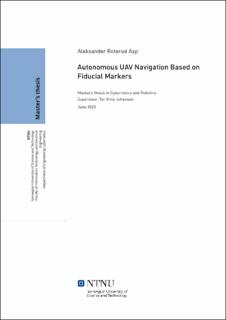| dc.contributor.advisor | Johansen, Tor Arne | |
| dc.contributor.advisor | Zolich, Artur | |
| dc.contributor.author | Asp, Aleksander Roterud | |
| dc.date.accessioned | 2021-09-23T18:17:51Z | |
| dc.date.available | 2021-09-23T18:17:51Z | |
| dc.date.issued | 2020 | |
| dc.identifier | no.ntnu:inspera:56990118:20997069 | |
| dc.identifier.uri | https://hdl.handle.net/11250/2780981 | |
| dc.description.abstract | Droner vokser raskt i popularitet for å gjennomføre oppdrag i miljø hvor det er problematisk for mennesker å utføre oppgaver manuelt. De utmerker seg med hensyn til både sikkerhet og effektivitet, men nøyaktigheten i landingsfasen for autonome droner er en betydelig utfordring. Denne avhandlingen presenterer forfatteren sitt bidrag i den kontinuerlige utviklingen av et system hvor en drone skal autonomt lande på og plukke opp en mikro undervannsglider. Dette skal gjennomføres med bruk av datasyn og DUNE - Unified Navigation Environment.
I denne avhandlingen presenteres en spesiallaget markør, tilpasset til bruk ved havoverflaten. Et automatisk HSV filter er opprettet og optimert til å kun filtrere gjennom aerospace-oransjefargede objekter fra kamerabildet. En grunnleggende kamerakalibreringsmetode ved hjelp av OpenCV og CharUco-brett er beskrevet og brukt for å kompensere for radiell og tangentiell forvrengning. Videre er en fargedetekteringsmetode beskrevet som en innledende prosedyre for å anskaffe navigeringsmål. Hoved manøvreringen er derimot basert på posisjon- og orientering-estimering av ArUco markøren inne i den spesiallagde markøren. Et constant bearing guidance system er definert og implementert, og en forenklet bølge-approksimering er brukt til å teste om systemet er levedyktig i havmiljø. En tilstandsmaskin som styrer både simulerte og reelle flyvninger er presentert, samt resultater fra disse typer flyvninger.
Simuleringsresultater med kamerabasert navigasjon og stasjonære markører produserer nøyaktig landinger. Forholdene er derimot ikke realistiske; det er ingen simulert vind, terreng er havblått, og ingen lysrefleksjon kan inntreffe.
Feltprøver viser at det automatiske HSV-filteret er utilstrekkelig, da filtreringen er inkonsekvent. Et statisk HSV-filter er optimalisert basert på data fra en 3DR Solo-drone, og viser seg å være svært allsidig. En oppbygging av forsinkelse i bildeoverføring begrenser evalueringen av de implementerte navigasjonsmetodene med hensyn til dronemanøvrering. Imidlertid diskuteres nøyaktigheten til de oppnådde navigasjonsmålene. | |
| dc.description.abstract | Drones are quickly rising in popularity for carrying out missions in environments where humans have difficulties performing tasks manually. They excel in regards to both safety and efficiency. However, accuracy in the landing phase for autonomous drones is a significant challenge. This thesis presents the author's contribution in the continued development of a system where a drone is to land on and pick up a micro underwater glider autonomously. This operation is to be performed using computer vision and DUNE - Unified Navigation Environment.
In this thesis, a custom fiducial marker for use in ocean surface environments is presented. An automatic HSV filter is created and optimized to solely filter through aerospace-orange-colored objects from the camera view. A basic camera calibration method using OpenCV and CharUco boards to compensate for radial and tangential distortion is detailed. Next, a color detection scheme is described as an initial method to provide a navigational target. However, the main maneuvering is performed based on the detection and pose estimation of the ArUco marker within the custom marker. A constant bearing guidance system is presented and implemented, and a simplified wave approximation is defined and used to test viability in oceanic environments. A state machine that governs simulated and real flights is presented, as well as the results of these types of flight.
Simulation results with camera-based navigation and stationary markers produce highly accurate landings. However, the conditions are not realistic; there is no simulated wind, the terrain is a monochrome blue color, and no light reflection can occur.
Field tests prove the automatic HSV filter to be inadequate, as its performance is inconsistent. A static HSV filter is optimized based on data from a 3DR Solo drone, and is shown to be highly versatile. A build-up in camera feed delay limits evaluation of the implemented navigation methods with respect to drone maneuvering. However, the accuracy of the navigation targets acquired is discussed. | |
| dc.language | | |
| dc.publisher | NTNU | |
| dc.title | Autonomous UAV Navigation Based on Fiducial Markers | |
| dc.type | Master thesis | |
